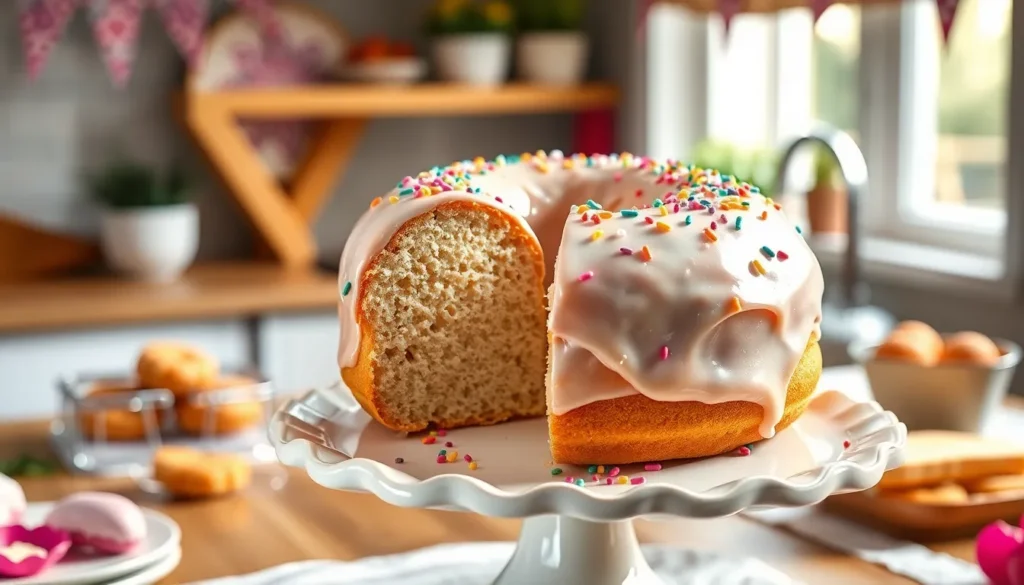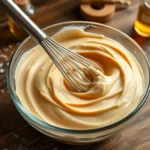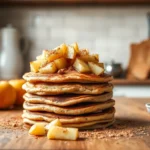We’ve discovered the ultimate dessert that combines two beloved treats into one irresistible creation: donut cake. This ingenious hybrid captures all the fluffy sweetness of your favorite glazed donut while delivering the satisfying portion size of a proper cake slice.
What makes donut cake so special? It’s the perfect marriage of textures and flavors that’ll transport you straight to your local bakery. We’re talking about that signature donut taste – slightly dense yet tender crumb with a hint of nutmeg and vanilla – all wrapped up in an easy-to-slice cake format that feeds a crowd.
Whether you’re planning a weekend brunch, celebrating a birthday, or simply craving something extraordinary for dessert, this donut cake delivers every time. The best part? You don’t need any fancy equipment or hard-to-find ingredients. We’ll show you how to create this bakery-style masterpiece right in your own kitchen using simple pantry staples.
Ingredients
We’ve carefully selected ingredients that deliver the perfect balance of donut shop flavor and cake texture. These pantry staples work together to create our signature donut cake without requiring any specialty items.
For the Cake
- 2 cups all-purpose flour
- 1 cup granulated sugar
- 2 teaspoons baking powder
- 1 teaspoon ground nutmeg
- 1/2 teaspoon salt
- 1/2 cup unsalted butter, melted
- 2/3 cup whole milk
- 2 large eggs, room temperature
- 1 teaspoon vanilla extract
For the Glaze
- 2 cups powdered sugar
- 1/4 cup whole milk
- 2 tablespoons unsalted butter, melted
- 1 teaspoon vanilla extract
- 1/8 teaspoon salt
Equipment Needed

Creating this delicious donut cake requires basic kitchen equipment that most home bakers already have on hand. We recommend gathering these essential tools before starting your baking process to ensure smooth preparation.
Essential Baking Equipment:
- Bundt or Tube Pan: These specialized pans create the signature donut shape that makes this dessert so visually appealing. The hollow center allows for even baking and authentic presentation.
- Electric Mixer: Stand mixers or hand mixers work perfectly for creaming butter and sugar to achieve the light, fluffy texture we want in our cake.
- Large Mixing Bowls: We need at least two bowls for separating wet and dry ingredients during the mixing process.
- Measuring Cups and Spoons: Accurate measurements are crucial for achieving the perfect donut cake texture and flavor balance.
- Rubber Spatulas: These tools help us fold ingredients gently and scrape down bowl sides for thorough mixing.
For Glazing and Finishing:
- Wire Cooling Rack: Proper cooling prevents condensation and ensures our glaze adheres perfectly to the cake surface.
- Small Whisk: This helps create a smooth, lump-free glaze that coats evenly.
- Pastry Brush or Spoon: Either tool works well for applying the glaze in smooth, even layers.
Optional Display Equipment:
- Cake Stand: A decorative stand elevates the presentation and makes serving easier for special occasions.
- Offset Spatula: This tool provides better control when applying glaze or transferring the finished cake.
Most home kitchens contain these basic tools already. We designed this recipe specifically to avoid requiring specialized equipment beyond the Bundt pan, making it accessible for bakers of all experience levels.
Instructions
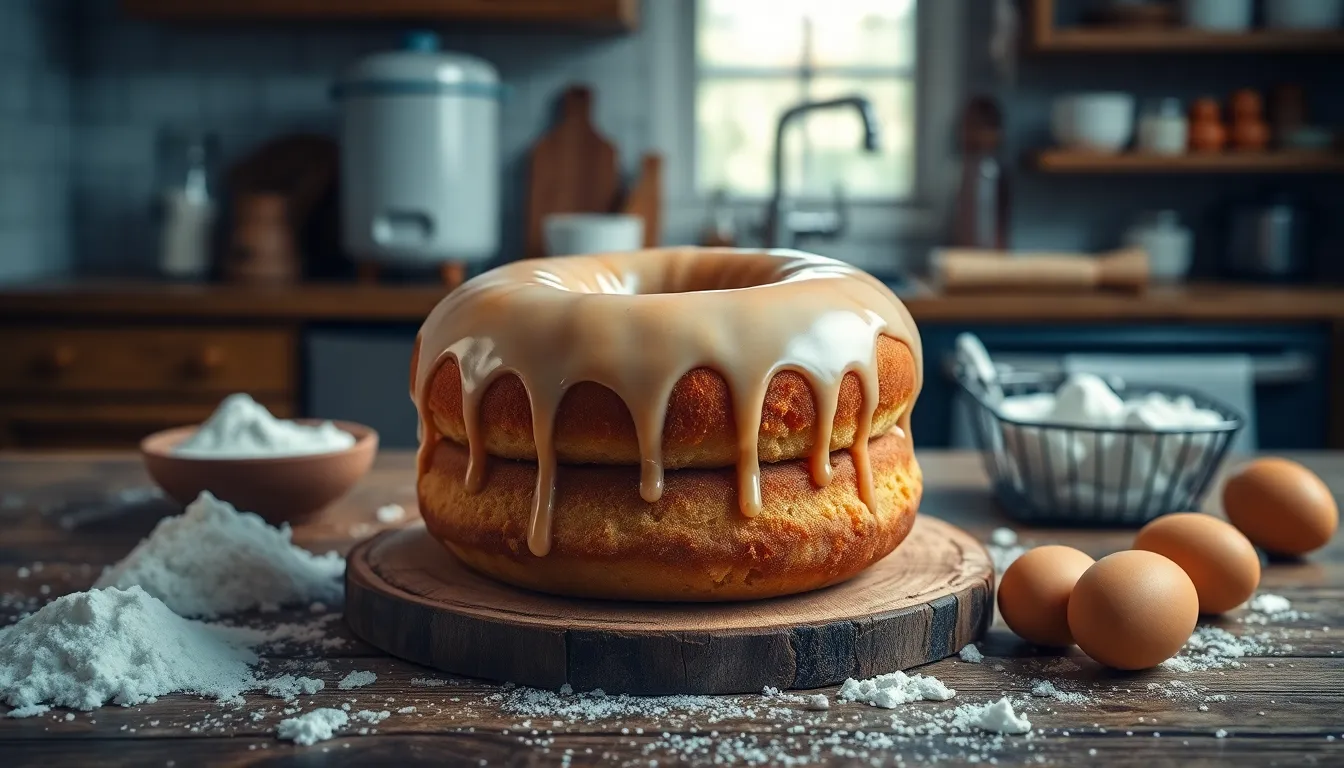
Follow these step-by-step instructions to create your perfect donut cake. Each stage builds upon the previous one to ensure the best texture and flavor.
Prep the Pan and Oven
Preheat your oven to 345°F and position the rack in the center for even baking. Generously grease your 10-inch bundt pan with softened butter or shortening, making sure to coat every ridge and curve. Dust the greased pan with flour, tapping out any excess to prevent sticking. This preparation ensures your donut cake will release cleanly from the pan.
Make the Cake Batter
Cream the softened unsalted butter and granulated sugar in your stand mixer or with a hand mixer until the mixture becomes light and fluffy, about 2-3 minutes. Add eggs one at a time, beating well after each addition to ensure proper incorporation. Mix in the vanilla extract until combined.
In a separate large bowl, whisk together the all-purpose flour, baking powder, baking soda, salt, and ground nutmeg. The nutmeg provides that signature donut shop flavor we’re aiming for.
Alternate adding the dry ingredients and buttermilk to your butter mixture in three additions, beginning and ending with the flour mixture. Mix just until the ingredients are combined to keep your cake tender. Overmixing will result in a tough texture.
Bake the Donut Cake
Pour the batter into your prepared bundt pan and smooth the top with a spatula. Tap the pan firmly on your counter several times to release any air bubbles that could create holes in your finished cake.
Bake for 45-55 minutes until the edges turn golden brown and a toothpick inserted into the center comes out clean or with just a few moist crumbs. The exact timing depends on your oven, so start checking at 45 minutes.
Cool the cake in the pan for 10-15 minutes before inverting it onto a wire cooling rack. This resting time prevents the cake from breaking apart when you remove it from the pan.
Prepare the Glaze
While your cake cools completely, whisk together the powdered sugar, milk, melted butter, vanilla extract, and salt until smooth and pourable. The glaze should coat the back of a spoon but still drip easily. Add more milk for a thinner consistency or more powdered sugar to thicken as needed.
Glaze and Finish
Once your cake has cooled completely, brush or drizzle the glaze evenly over the entire surface. Start at the top and let gravity help distribute the glaze down the sides for that classic donut appearance. Allow the glaze to set for 15 minutes before slicing and serving your homemade donut cake.
Directions for Serving
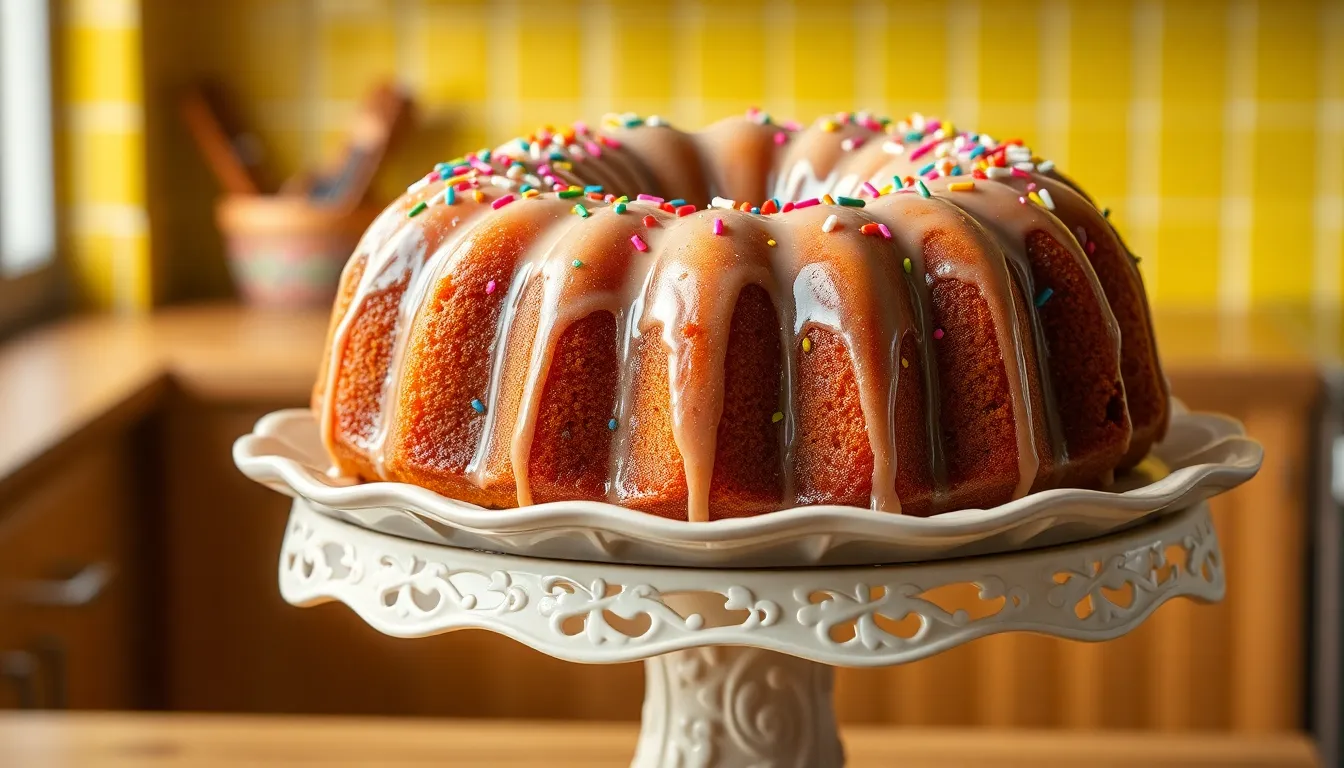
We recommend serving our donut cake at room temperature to achieve the best flavor and texture balance. Allow the cake to rest for at least 30 minutes after glazing to let the sweet coating set properly.
Temperature and Timing
Room temperature serving brings out the cake’s full donut shop flavor profile. The glaze maintains its perfect consistency when not chilled while the cake crumb stays tender and moist.
Presentation Techniques
Start by placing the glazed cake on a decorative cake stand or serving platter. The bundt shape creates an impressive centerpiece that showcases the glossy glaze dripping down the ridged sides. We suggest adding colorful sprinkles while the glaze remains slightly wet for a festive donut shop appearance.
Slicing and Portioning
Use a sharp serrated knife to cut clean slices without disturbing the glaze. Wipe the blade between cuts to maintain neat presentation. Each slice should be approximately 1 to 1.5 inches thick to provide satisfying portion sizes that mirror traditional cake servings.
Storage Guidelines
| Storage Method | Duration | Temperature |
|---|---|---|
| Airtight container | 3-4 days | Room temperature |
| Refrigerated | 5-7 days | 35-40°F |
| Frozen | 2-3 months | 0°F |
Store leftover cake in an airtight container to maintain freshness and prevent the glaze from hardening. Avoid refrigeration unless necessary as cold temperatures can make the cake dense and affect the glaze texture.
Serving Accompaniments
Fresh coffee or cold milk pairs beautifully with our donut cake’s sweet glaze and tender crumb. Consider offering vanilla ice cream alongside warm slices for an elevated dessert experience that combines hot and cold temperatures.
Storage Tips
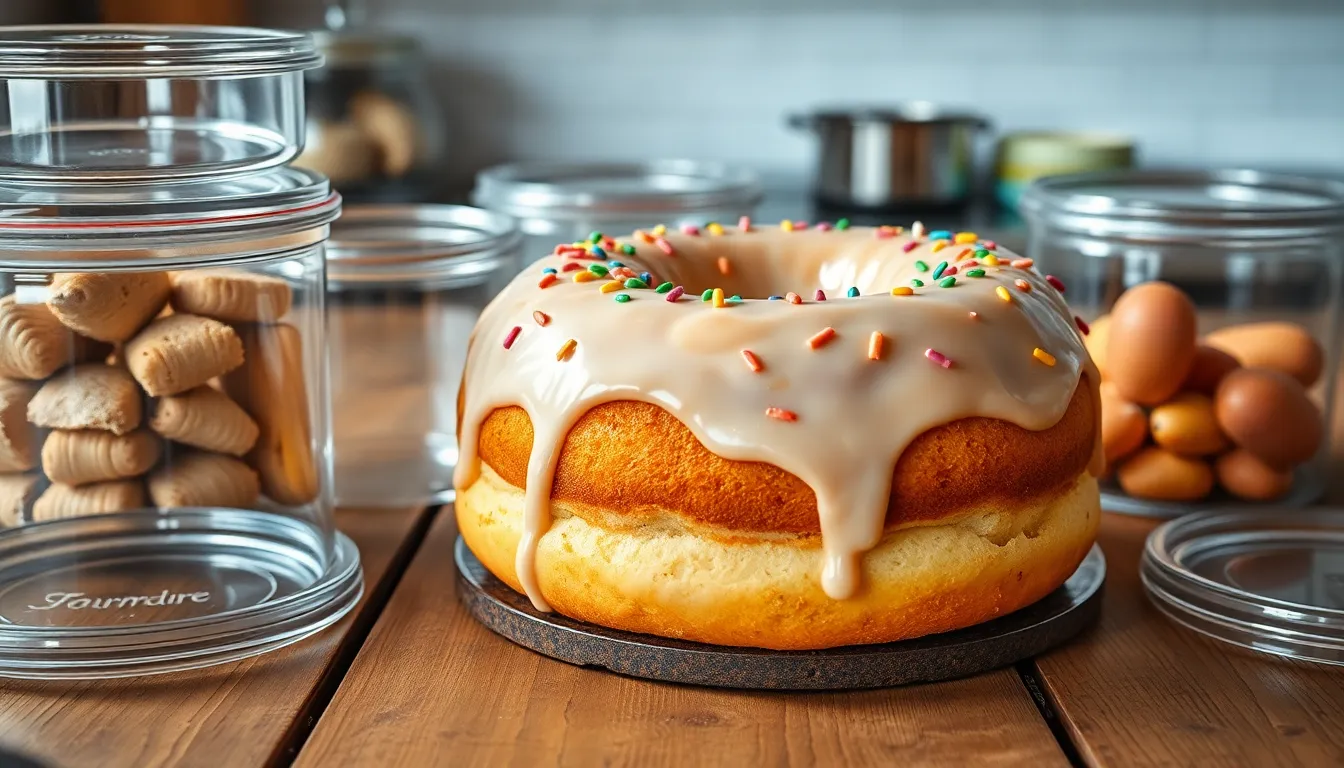
We recommend storing your donut cake properly to maintain its fresh texture and delicious glaze. Our storage approach depends on how long you plan to keep the cake and the type of frosting used.
Room Temperature Storage
Store your donut cake in an airtight container or sealed plastic bag at room temperature for optimal freshness. We find this method works best for short-term storage up to two days. Keep the container away from direct sunlight and heat sources to prevent the glaze from melting or the cake from drying out.
Refrigeration Guidelines
Refrigerate your donut cake when it features temperature-sensitive frostings like cream cheese or whipped cream. We suggest this method maintains both texture and freshness better than room temperature storage for glazed varieties. Allow the cake to come to room temperature before serving for the best flavor experience.
Airtight Container Benefits
Use airtight containers or plastic bags to prevent air exposure that causes staleness. We emphasize this step because proper sealing keeps moisture in and air out. This simple technique extends your cake’s freshness significantly compared to leaving it uncovered.
Freezing for Long-Term Storage
Freeze your donut cake in an airtight container when storing for longer than three days. We recommend this method for extended storage periods. Thaw the cake at room temperature when ready to serve, allowing it to return to its original texture naturally.
Pre-Storage Preparation
Ensure your donut cake cools completely before storing to prevent moisture buildup inside the container. We also suggest wrapping cardboard boxes in plastic wrap or aluminum foil to retain moisture if using this storage method. This extra step helps maintain the cake’s signature soft texture.
| Storage Method | Duration | Container Type | Temperature |
|---|---|---|---|
| Room Temperature | Up to 2 days | Airtight container/sealed bag | 68-72°F |
| Refrigerated | 3-5 days | Airtight container | 35-40°F |
| Frozen | Up to 3 months | Airtight container | 0°F |
Make-Ahead Instructions
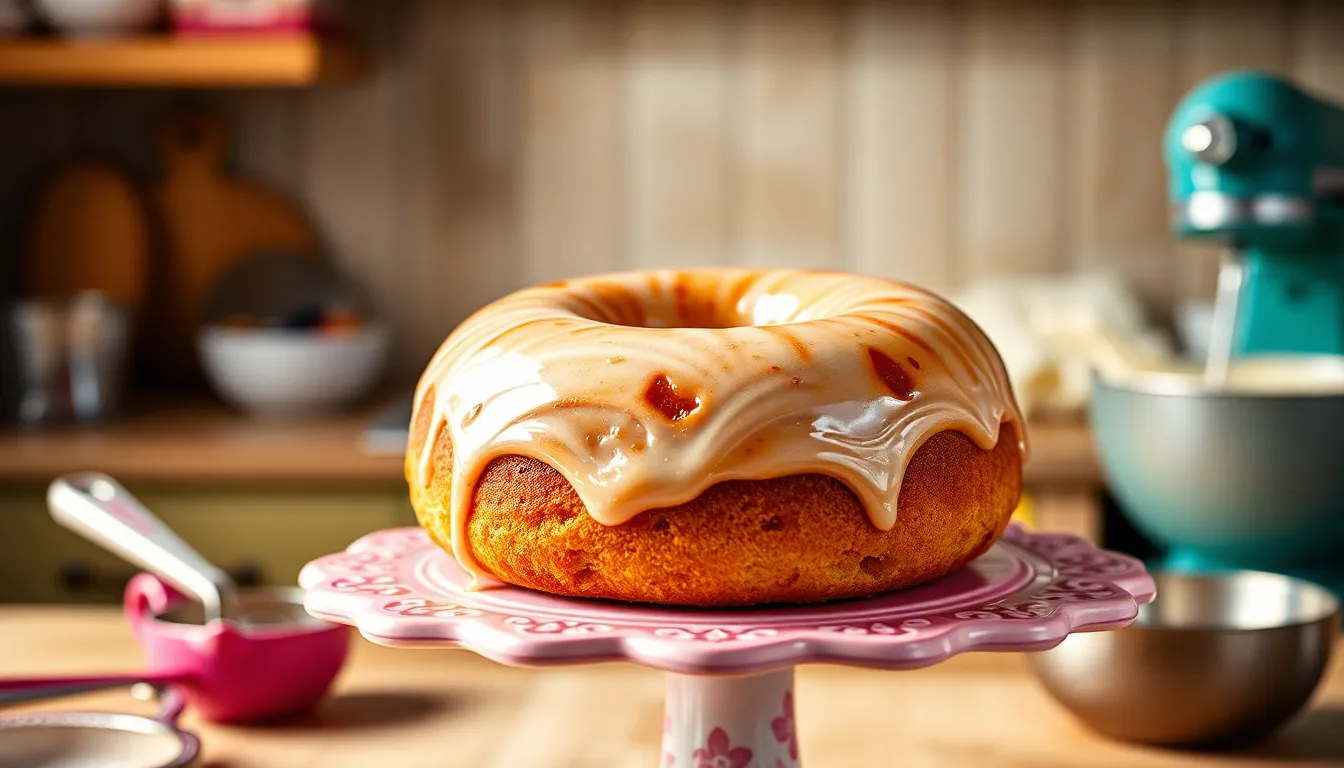
Planning ahead transforms this donut cake into the perfect stress-free dessert for any gathering. We recommend preparing the entire cake up to three days before your event for optimal convenience and flavor development.
Advance Preparation Timeline
Our donut cake actually improves in flavor when made ahead of time. The cake layers benefit from resting as the flavors meld together beautifully. Store your completed cake covered at room temperature for up to three days before serving.
Proper Storage Methods
Room temperature storage works best for maintaining the cake’s signature soft texture. Cover the glazed cake with a large cake dome or place it in an airtight container. Keep the storage area away from direct sunlight and heat sources to prevent the glaze from becoming too soft.
Freezing for Extended Storage
Long term storage becomes simple when you freeze the donut cake for up to three months. Wrap the completely cooled cake tightly in plastic wrap before placing it in an airtight freezer container. Remove any air pockets to prevent freezer burn from affecting the cake’s quality.
Thawing and Final Preparation
Thaw your frozen donut cake overnight in the refrigerator for the best results. Allow the cake to come to room temperature for at least 30 minutes before serving. This resting period ensures the texture returns to its optimal softness and the flavors reach their full potential.
Glazing Strategy for Make Ahead Cakes
Apply the glaze just before serving when making the cake ahead of time. Powdered sugar glazes can absorb into the cake surface over extended storage periods. Store the unglazed cake and prepare a fresh batch of glaze on serving day for the most attractive presentation and authentic donut shop appearance.
Variations and Flavor Options
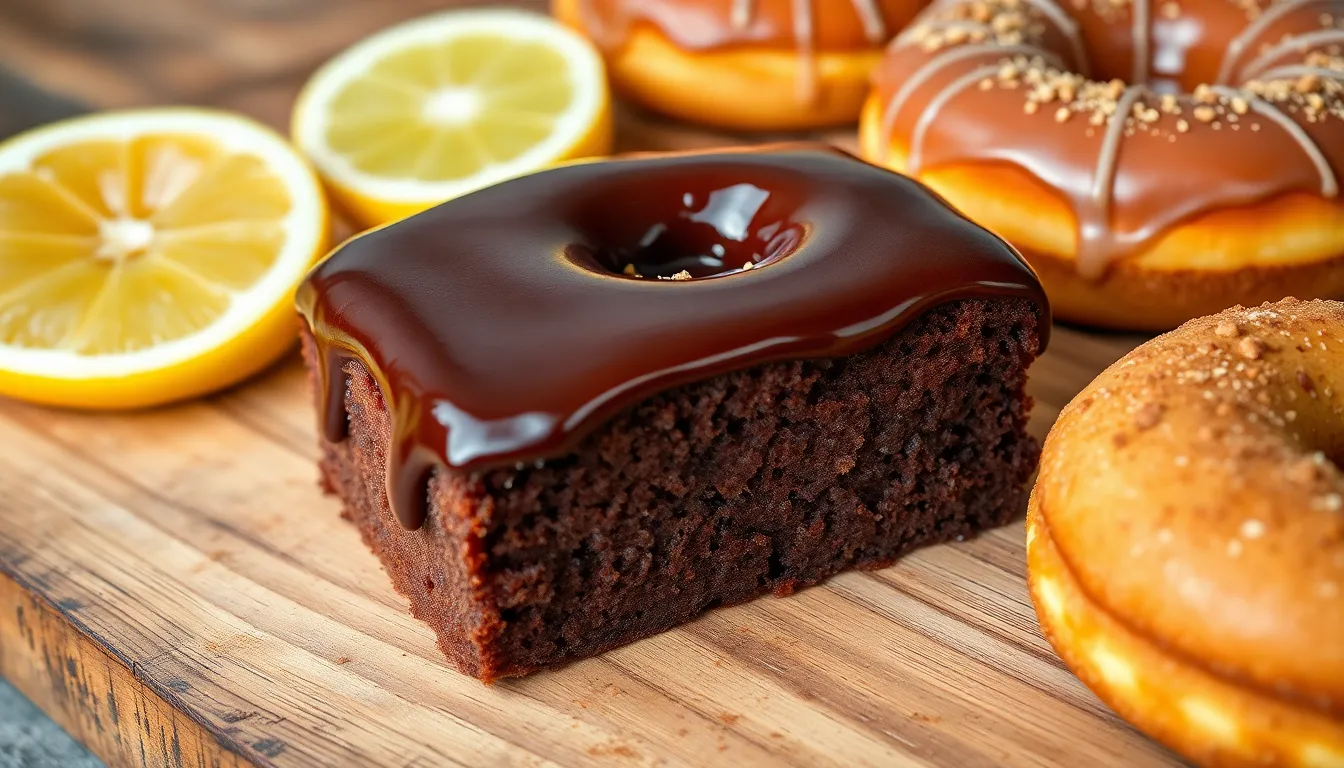
Our donut cake transforms beautifully into different flavor profiles while maintaining its signature baked texture and convenient slice format. Each variation captures the essence of beloved donut shop favorites with unique glazes and toppings that elevate the traditional recipe.
Chocolate Donut Cake
We create this rich variation by incorporating Dutch process cocoa into our base batter alongside buttermilk and sour cream for exceptional moisture. The chocolate version delivers a deep cocoa flavor that rivals any bakery donut while maintaining the tender crumb we love in cake form. Our favorite topping combinations include a glossy chocolate glaze that mirrors traditional glazed donuts or a vanilla glaze that provides beautiful contrast against the dark cake.
We enhance the chocolate experience by adding a light dusting of nutmeg or cardamom to the batter for subtle complexity. The finished cake pairs wonderfully with chocolate cream cheese frosting and an artistic chocolate drizzle for special occasions. This variation holds its shape perfectly when sliced and maintains the authentic donut appearance that makes our cake so appealing.
Lemon Donut Cake
Fresh lemon zest and juice transform our basic recipe into a bright citrus celebration that captures spring and summer flavors. We incorporate these ingredients directly into the batter along with yogurt for tangy depth and extra moisture. The lemon variation offers a lighter alternative to chocolate while delivering the same satisfying texture and portion control benefits.
Our signature lemon glaze creates the perfect finishing touch with its glossy appearance and concentrated citrus flavor. We prepare this topping using fresh lemon juice and powdered sugar for authentic taste that complements the cake without overwhelming it. The combination creates a dessert that feels both familiar and refreshing.
Cinnamon Sugar Donut Cake
This variation recreates the beloved old fashioned donut experience through warm spices and traditional coating techniques. We add ground cinnamon directly to our cake batter for flavor throughout every bite. After baking and cooling our bundt cake we brush the surface with melted butter and roll it in cinnamon sugar for authentic texture and taste.
The coating process mimics the traditional donut shop method while working perfectly with our cake format. We find this variation particularly appealing for breakfast gatherings and autumn celebrations when warm spices feel most appropriate. The cinnamon sugar exterior creates a delightful contrast with the tender interior while maintaining our signature donut shape and easy serving portions.
Troubleshooting Tips
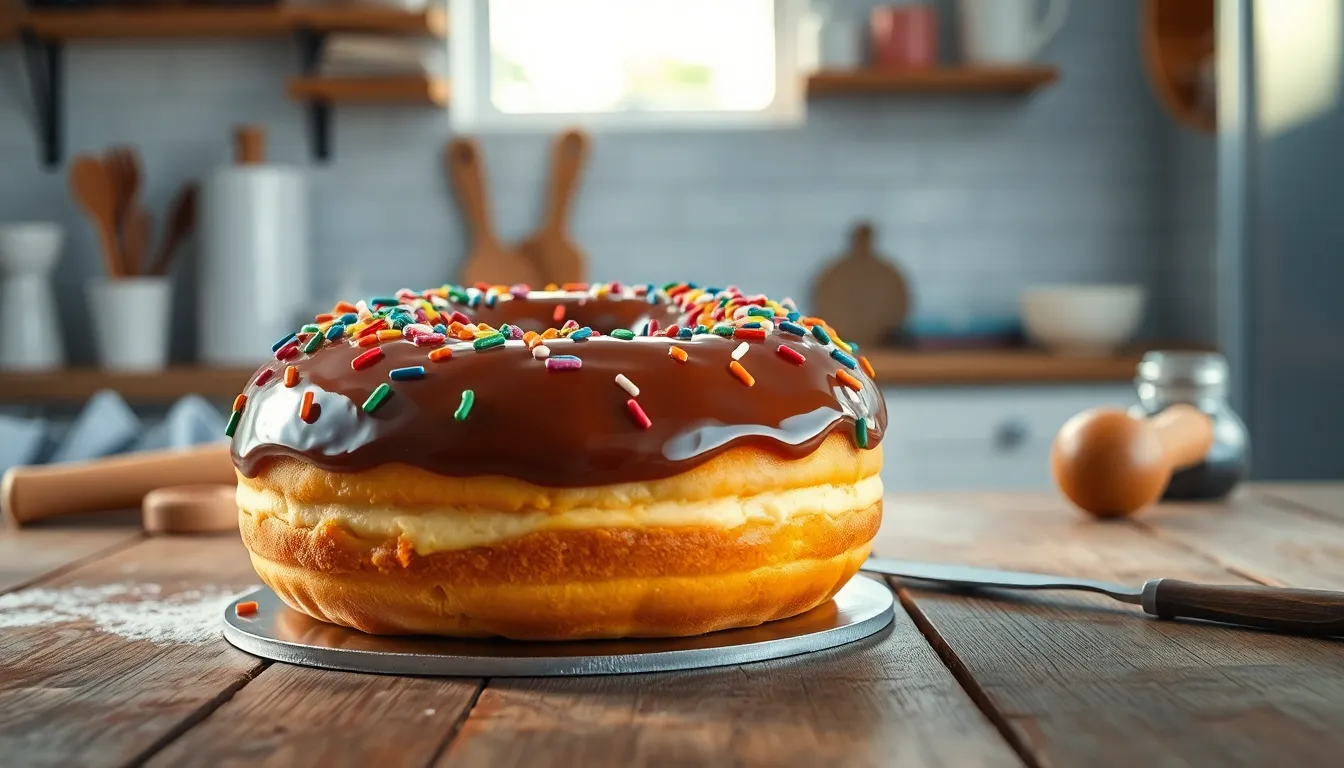
We understand that creating the perfect donut cake can sometimes present challenges. These common issues and their answers will help you achieve bakery-quality results every time.
Dense or Heavy Texture
Our donut cake should have a light, fluffy crumb similar to a glazed donut. When your cake turns out dense or heavy, we recommend checking these key factors:
Fresh Leavening Agents – We always verify that our baking powder is fresh and measured accurately. Stale or insufficient baking powder prevents proper rising and creates a dense texture.
Gentle Mixing Technique – We mix the batter until ingredients are just combined. Over-mixing develops gluten strands, which leads to a tough, heavy cake rather than the tender crumb we want.
Room Temperature Ingredients – We ensure all ingredients reach room temperature before mixing. This allows for even distribution and proper chemical reactions that create our desired light texture.
Dry or Crumbly Results
A properly made donut cake maintains moisture and tenderness. When your cake becomes dry or crumbly, we focus on these corrections:
Moisture Balance – We double-check the ratio of liquid to dry ingredients in our recipe. Too little liquid produces a dry batter that bakes into a crumbly cake.
Adequate Fat Content – We review our recipe to ensure sufficient fat content, as this ingredient provides essential moisture and tenderness to the final product.
Baking Time and Storage – We avoid overbaking by testing doneness with a toothpick at the minimum baking time. Proper storage in airtight containers prevents moisture loss after baking.
Cracking or Misshapen Appearance
Our donut cake should bake evenly with a smooth, golden surface. When cracks or uneven shapes occur, we address these factors:
| Temperature Factor | Optimal Range |
|---|---|
| Batter Temperature | 70°F-72°F (22°C-23°C) |
| Oven Temperature | 345°F (174°C) |
Batter Temperature Control – We maintain our batter temperature between 70°F and 72°F before baking. This ensures even rising and prevents surface cracking.
Proper Pan Preparation – We thoroughly grease and flour our Bundt pan, paying special attention to intricate details that might cause sticking or tearing.
Undercooked Centers
We want our donut cake to be fully cooked throughout while maintaining moisture. When centers remain raw or gummy, we make these adjustments:
Extended Baking Time – We increase baking time in 5-minute increments, testing with a toothpick until it comes out with just a few moist crumbs.
Temperature Verification – We use an oven thermometer to confirm our oven reaches the correct temperature, as inaccurate readings can cause uneven baking.
Pan Size Considerations – We ensure we use the correct pan size specified in our recipe, as larger pans create thinner layers that bake faster.
Glaze Issues
Our signature glaze should coat the cake smoothly and set properly. When glaze problems occur, we troubleshoot these areas:
Glaze Consistency – We adjust the powdered sugar to liquid ratio to achieve a coating that flows smoothly but isn’t too thin.
Application Timing – We wait for our cake to cool completely before glazing, as warm surfaces cause the glaze to run off or become absorbed.
Setting Problems – We allow 30 minutes for the glaze to set at room temperature before serving or storing the cake.
Conclusion
We’ve shown you how to create a bakery-quality donut cake that brings together the best of both worlds. This versatile dessert transforms simple pantry ingredients into something truly special that’ll impress your family and friends.
Whether you stick with the classic glazed version or experiment with chocolate lemon or cinnamon sugar variations the result is always delicious. The make-ahead friendly nature means you can prepare it for any occasion without stress.
With our detailed instructions troubleshooting tips and storage guidelines you’re equipped to master this unique dessert. Your kitchen will soon be filled with the irresistible aroma of fresh donut cake that rivals any bakery creation.
Frequently Asked Questions
What is a donut cake?
A donut cake is a delightful dessert that combines the fluffy sweetness of glazed donuts with the portion size and texture of a traditional cake. It offers the signature taste of donut shop favorites in an easy-to-slice format, making it perfect for sharing at brunches, birthdays, or special occasions.
What ingredients do I need to make donut cake?
For the cake, you’ll need all-purpose flour, granulated sugar, baking powder, ground nutmeg, salt, melted unsalted butter, whole milk, eggs, and vanilla extract. The glaze requires powdered sugar, whole milk, melted butter, vanilla extract, and a pinch of salt. These are common pantry staples most home bakers already have.
What equipment is needed to make donut cake?
Essential equipment includes a Bundt or tube pan for the signature shape, an electric mixer, large mixing bowls, measuring cups and spoons, and rubber spatulas. For glazing, you’ll need a wire cooling rack, small whisk, and pastry brush. Optional items like a cake stand and offset spatula can enhance presentation.
How do I bake the perfect donut cake?
Preheat your oven to 345°F and prepare your Bundt pan. Cream butter and sugar, add eggs and vanilla, then alternate dry ingredients with buttermilk. Pour batter into the pan and bake for 45-55 minutes until golden brown. Cool completely before glazing for best results.
How should I store donut cake?
Store at room temperature in an airtight container for up to two days. For longer storage, refrigerate for 3-5 days or freeze for up to three months. Always cool completely before storing and bring refrigerated cake to room temperature before serving for optimal texture and flavor.
Can I make donut cake ahead of time?
Yes! Donut cake can be prepared up to three days in advance and actually improves in flavor when allowed to rest. Store covered at room temperature or freeze for longer storage. Apply glaze just before serving to maintain the best appearance and fresh taste.
What flavor variations can I make?
Popular variations include chocolate donut cake using Dutch process cocoa, lemon donut cake with fresh zest and juice, and cinnamon sugar donut cake with warm spices. Each variation maintains the signature texture while offering different flavor profiles to suit various preferences and occasions.
Why is my donut cake dense or dry?
Dense texture often results from overmixing the batter or using old leavening agents. Dryness can occur from overbaking or incorrect ingredient ratios. Use fresh baking powder, mix gently, check oven temperature accuracy, and avoid overbaking. Proper ingredient temperatures also ensure better texture.
How do I fix glaze problems?
If glaze is too thick, add milk gradually until desired consistency. If too thin, add more powdered sugar. Ensure the cake is completely cool before glazing to prevent melting. For best coverage, apply glaze in thin layers and allow each layer to set before adding more.
What’s the best way to serve donut cake?
Serve at room temperature for optimal flavor and texture, allowing it to rest for at least 30 minutes after glazing. Use a sharp serrated knife for clean slices. Enhance the experience with fresh coffee, cold milk, or vanilla ice cream as accompaniments.

